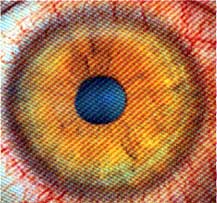Q What causes the Cornea and Contact Lens Research Units (CCLRU) definition of contact lens-induced acute red eye response (CLARE)?
A The Institute for Eye Research (IER)which incorporates CCLRU, a core partner of the Vision Coop- erative Research Center in Sydney, Australiadefines CLARE as an inflammatory reaction of the cor-nea and conjunctiva subsequent to a period of eye closure with soft lens wear. The disorder is characterized by small focal and diffuse peripheral corneal infiltrates with minimal or no epithelial involvement.
Studies suggest that high levels of Gram-negative bacteria, such as Pseudomonas species (putida and aeruginosa) and Ser-ratia marcescens, are the culprit.1,2
Interestingly, however, these are not the invasive or infective types of these organisms, says Professor Brien Holden, Ph.D., consultant to the IER. They only provoke inflammation, presumably due to the release of toxins from our environment.
Optometrist Kathy Dumbleton, of the Centre for Contact Lens Res-earch at the University of Waterloo in Ontario, says Haemophilus influ- enzae has also been implicated in the recruitment of inflammatory cells.3
Corneal hypoxia may also trigger CLARE.4
 |
| High levels of Gram-negative bacteria may cause CCLRU"s definition of CLARE. |
Q What is the stepladder of treatment for patients who have CLARE?
A Treatment should consist of:
- Removing the contact lens. CLARE is an endotoxin-driven response, not an infection, so Dr. Holden says the key diagnostic feature is relief via lens removal. Lens wear should be suspended until there is a full resolution of the signs and symptoms, Dr. Dumbleton adds.
- Ocular lubricants and anti-inflammatory agents, if needed. While lens removal will resolve the problem in most cases, ocular lubricants and anti-inflammatory drugs can also be used. Optometrist Ernie Bowling, of Summerville, Ga., suggests using a non-preserved artificial tear, every two or four hours for 24 to 48 hours. Dr. Dumbleton recommends artificial tears q1h for two to three days.
If the patient has severe CLARE with no accompanying infection, optometrist Robert Terry of the IER, suggests using an anti-inflammatory, such as fluorometholone or Pred Forte (prednisolone acetate 1%, All-ergan), every six hours for two to three days to hasten recovery. - Patient follow-up. After lens removal and/or use of drops, make sure the CLARE is gone. You want to watch it [CLARE] for a while, and make sure the patient presents with that quiet white eye again, Dr. Bowling says.
Carefully monitor the patient to ensure the CLARE isnt a more serious case of infectious keratitis, Dr. Dumbleton adds. - Prophylactic treatment. If there is a rare, significant epitheliopathy, use a broad-spectrum medication such as a fluoroquinolone. Some clinicians, however, may opt for a combination drug such as Tobra- Dex (tobramycin 0.3% and dexamethasone 0.1% ophthalmic suspension, Alcon).
- Patient education. Have the patient reduce wearing time and initially avoid overnight wear. Once lens wear can be resumed, instruct the patient to practice lid hygiene with warm compresses and lid scrubs daily, Dr. Dumbleton says.
- Holden BA, La Hood D, Grant T, et al. Gram-negative bacteria can induce contact lens related acute red eye (CLARE) responses. CLAO J 1996 Jan;22(1):47-52.
- Willcox MD, Power KN, Stapleton F, et al. Potential sources of bacteria that are isolated from contact lenses during wear. Optom Vis Sci 1997 Dec;74(12):1030-8.
- Sankaridurg PR, Willcox MD, Sharma S, et al. Haemophilus influenzae adherent to contact lenses associated with production of acute ocular inflammation. J Clin Microbiol 1996 Oct;34(10):2426-31.
- Binder PS. The physiologic effects of extended wear soft contact lenses. Ophthalmology 1980 Aug;87(8):745-9.

